Apple's iPhone 4: Thoroughly Reviewed
by Brian Klug & Anand Lal Shimpi on June 30, 2010 4:06 AM EST- Posted in
- Smartphones
- Apple
- iPhone 4
- Gadgets
- Mobile
Screen - Retina Display
Right out of the box, the iPhone 4's new 326 PPI, 960x640, 3.5" display is arguably the single most striking change the new iPhone brings. In a word, it's dazzling. Text and high res images look amazingly sharp on the iPhone 4’s retina display. It’s an improvement over the 800 x 480 AMOLED screens that have been shipping on most Android phones. But if you’re comparing it to an iPhone 3GS the difference is huge.
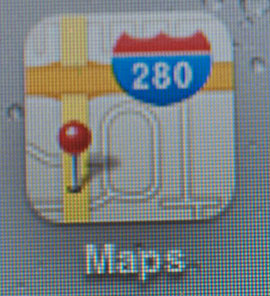 |
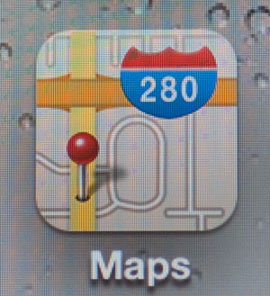 |
|
iPhone 3GS
|
iPhone 4
|

Text on the Google Nexus One

Text on the iPhone 4
The dot pitch is truly remarkable, so much so that Apple makes the claim that their display outresolves the human eye; its advertised ability to do so has earned it a new Apple tradename, "retina display."
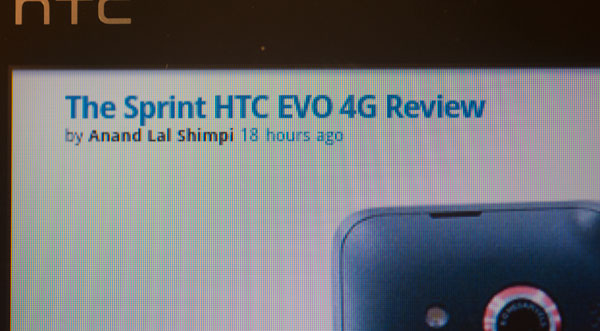
Text on the HTC EVO 4
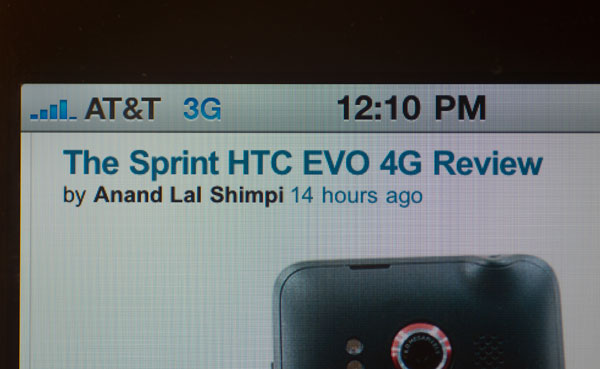
Text on the iPhone 4

AnandTech Logo on the EVO 4G

AnandTech Logo on the iPhone 4
Immediately after hearing Apple's claim that the Retina Display outresolves the human eye, I snapped into optics mode and crunched the numbers, and tweeted that the results were valid.
In the days that followed, there was considerable debate about the validity of Apple's claims. However, nearly all of the debate really just hinged on a debate over angular resolution of the human eye, and a little more over viewing distance. They're both entirely conventions.
As you've probably discovered by now, the human eye resolution can really only be characterized in angular subtense. Hold something closer to your eye, and you can see smaller features better (in theory), move it further away, and you can't make out small spatial details. The minimum angle visible with the human eye is the angle at which features (for the most common definition, a black and white square wave) stop being visible, and are indistinguishable from each other.
Most measures of visual acuity test with this implicitly - the Snellen eye chart's use of the capital "E" is literally a perfect example, which has given rise to a "tumbling E" eye chart. At twenty feet, the capital E subtends 5 minutes of arc, and conveniently has five half cycles of white to black (from top to bottom). So 20/20 implicitly implies an angular resolution of 1 arcminute (1/60 degrees).
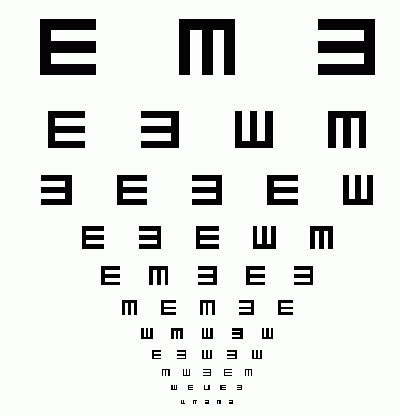
As an Optical Sciences and Engineering undergrad, I've had 1 arcminute drilled into my head more times than I can count as being the "normal" angular resolution of the human eye system. In practice, this is 20/20 vision, which is "normal," yet not perhaps the absolute maximum for human perfection. We can play games of course and argue that a small subset of the population has better than normal uncorrected vision, and thus an angular resolution of below 1 arcminute. I have above average uncorrected vision, which I've measured to be 20/15 on average, giving an angular resolution of approximately 0.75 arcminutes. Of course, the definitions stem from the spacing of cones in the fovea, the highest resolution part of the retina.
The other informational quantity needed to test the Retina Display claims is viewing distance. Again, there's a commonly agreed upon convention - standard viewing distance is considered to be 1 foot. This is another drilled into my brain number tossed around for comfortable viewing and reading. In practice, you can focus on objects much closer to your eye - this is called the near point and is often given as 10 inches, though as you get closer you increase strain aren't likely to keep it here.

Maybe not exactly the limit, but close enough.
Given the two most common standards tossed around, 1 arcminute and 12 inches, do the math out and you'll arrive at around 286 pixels per inch as the limit for eye resolving power, comfortably below the 326 on the Retina Display. Move to 0.75 arcminutes at 12 inches, and it's 382 pixels per inch, higher than the Retina Display. Honestly, I can't see the pixels at 12 inches.
Of course, the real story is even more complicated. Remember how the definition comes with the implicit assumption that we're dealing with a square wave pattern from white to black? That's a factor too - the contrast of the two pixels. Lower the contrast, and the eye's ability to pick out features decreases even more. So far, everything we've talked about has been first order, and without aberrations. Toss in spherical and astigmatism, two aberrations common to the eye system, and eye performance drops way more.
The human eye system is actually pretty poor, and shockingly easy to outresolve. In fact, if you saw the image your eye forms on your retina, you'd likely be appalled; it's your brain that makes the system usable. But at the end of the day, Apple's claims that the display outresolves the human eye are good enough for us.










270 Comments
View All Comments
Brian Klug - Wednesday, June 30, 2010 - link
I've read your commentary but don't see how we're in disagreement, about anything to be honest. I know for a fact that Apple is reporting RSSI (signal strength) in dBm and not using SNR. You'll just have to trust me that this is the case ;). This is entirely the point of the section - to illustrate just how useless that metric is especially in the case of the iPhone 4, and how much they need to use a different quality metric like CQI.In addition, this: "Because cellular carriers don't want clients to see less than 5 bars, so they have been pretty much rigged to display 5 bars in most situations until the signal is VERY BAD."
Is exactly what I've stated, a few times in so many words in the article. In fact, it's that kind of blatant lying about the dynamic range which makes this effect even more exacerbated. I realize that carriers have a vested interest in making the network look great everywhere - but turns out this ended up biting apple back with the iPhone 4 for reasons I stated.
I agree that normally -107 dBm of signal is bad, but have reason to believe that the iPhone 4's baseband deals just fine with the link even at that signal. Definitely grab someone's iPhone and try it out at -107 and -113; the amount of success I've had is unparalleled compared to other UMTS handsets I've played with.
-Brian
fhaddad922 - Wednesday, June 30, 2010 - link
The subject says it all, but I'll type it again for the slow.If you have any type of "smart" phone (I have no idea whats so "smart" about it) and you are paying $100+ per month to use it, you are really dumb. The only smart people are the ones that convinced you to buy this crap!
Now, if you are some type of a business owner and you need to keep in contact with employees or customers or something similar, than by all means, purchase one of these phones and use it.
But for the rest of the world (which is probably 90% of the readers here), why the f**k do you need a $100+ / month plan?
The phone does nothing that you need. Stop making the cell phone companies richy.
They talk about how good the camera is on it... IT SUCKS!
They talk about how good the video is on it... IT SUCKS!
They talk about how you have to hold the phone the right away... I bet one of the designers said "oops"
FaceTime.. lawl... really?
They are already gouging their customers. For example, to charge $0.25 to send a text message is asinine. It's not even $0.50 to put a letter in the mail and mail it across the country. How do they justify $0.25 to send a text message? On top of that, for $50.00 / month and you don't get unlimited calling. Thats dumb.
strikeback03 - Thursday, July 1, 2010 - link
Thank you for the anti-capitalist rantpetzi-bear - Wednesday, June 30, 2010 - link
Have you tried it with a glove?Should be easier that applying a thin film.
I thinking about clear coating the frame :-)
But a.) I am right handed
b.) I couldn't get my hands a phone yet - still sold out
Brian Klug - Wednesday, June 30, 2010 - link
Very good point, I'll try that too!-Brian
MonkeyPaw - Wednesday, June 30, 2010 - link
Actually, you might have more issues with the "touch of death" if you are right-handed. I'm a righty, and I hold cell's in my left hand all the time so that I can free my dominant hand for things like writing or mouse clicking.Personally, the iPhone4 is a nice step up, but I really question the design choices. Glass on both sides? A non-coated metal rim that doesn't like human touch? Serious engineering flaws for an otherwise well-designed device.
Brian Klug - Wednesday, June 30, 2010 - link
See this is exactly how I end up holding the phone. I hold it in my left hand (the wrong way) and use the right hand to tap, select, e.t.c.-Brian
vol7ron - Wednesday, June 30, 2010 - link
Trying with a glove would be interesting, since around here summers are hot and winters are cold (glove worthy).I was suggesting the film because many people I know use it because it makes the phone more pocket-worthy. Using a hard plastic case, or even a silicone case, provides unnecessary bulk, which is uncomfortable when wearing those stylish tight new pants -ha.
jasperjones - Wednesday, June 30, 2010 - link
usually i find something to criticize but not today. excellent review. that is it.jasperjones - Wednesday, June 30, 2010 - link
Actually I found something.The battery life figures for the Nexus One were simply copied from the original Nexus One review (when the phone ran 2.1/Eclair). This doesn't make sense as you updated all other figures (performance etc.) to reflect FroYo.
FroYo has much improved battery life on my Nexus One.